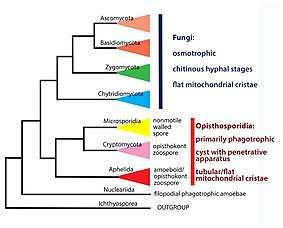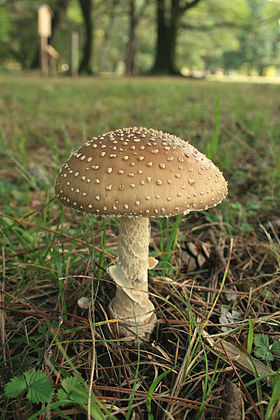Holomycota
clado de organismos eucariotas (Eukaryota) que consiste nos fungos (Fungi) e nos Cristidiscoidea
Holomycota é um clado monofilético que inclui os grupos-irmãos, Fungi e Cristidiscoidea.[1] O clado é baseado em análise de DNA mitocondrial e nuclear, que confirmaram a relação entre os dois grupos. Outros estudos já haviam demonstrado essa relação próxima.[2][3]
| Holomycota | |||||||
|---|---|---|---|---|---|---|---|
| Classificação científica | |||||||
| |||||||
| Grupos | |||||||

Filogenia
editarA árvore filogenética que se segue estabelece a relação do reino Fungi e sua estreita relação com outros organismos, com base no trabalho de Philippe Silar[4] e na obra The Mycota: A Comprehensive Treatise on Fungi as Experimental Systems for Basic and Applied Research.[5][6] The holomycota tree is following Tedersoo et al.[7][8][9] A estrutura filogenética do clado Holomycota é a seguinte:
| Opisthokonta |
| ||||||||||||||||||||||||||||||||||||||||||||||||||||||||||||||||||||||||||||||||||||||||||
Referências
- ↑ LIU, Y.; STEENKAMP, E.T.; BRINKMANN, H.; FORGET, L.; PHILIPPE, H.; LANG, B.F. (2009). «Phylogenomic analyses predict sistergroup relationship of nucleariids and Fungi and paraphyly of zygomycetes with significant support». BMC Evolutionary Biology. 9: 272e. PMID 19939264. doi:10.1186/1471-2148-9-272
- ↑ STEENKAMP, E.T.; WRIGHT, J.; BALDAUF, S.L. (2006). «The Protistan Origins of Animals and Fungi». Molecular Biology and Evolution. 23 (1): 93–106. PMID 16151185. doi:10.1093/molbev/msj011
- ↑ SHALCHIAN-TABRIZI, K.; MINGE, M.A.; ESPELUND, M.; ORR, R.; RUDEN, T.; JAKOBSEN, K.S.; CAVALIER-SMITH, T. (2008). «Multigene phylogeny of choanozoa and the origin of animals». PLoS ONE. 3 (5): e2098. PMID 18461162. doi:10.1371/journal.pone.0002098
- ↑ Silar P (2016). Protistes Eucaryotes: Origine, Evolution et Biologie des Microbes Eucaryotes. [S.l.]: HAL. p. 462. ISBN 978-2-9555841-0-1
- ↑ Esser K (2014). The Mycota VII A: Systematics and Evolution (2nd ed.). [S.l.]: Springer. p. 461. ISBN 978-3-642-55317-2
- ↑ Bass, David; Czech, Lucas; Williams, Bryony A. P.; Berney, Cédric; Dunthorn, Micah; Mahé, Frederic; Torruella, Guifré; Stentiford, Grant D.; Williams, Tom A. (28 de abril de 2018). «Clarifying the Relationships between Microsporidia and Cryptomycota». Journal of Eukaryotic Microbiology (em inglês). 65 (6): 773–782. ISSN 1066-5234. PMC 6282948 . PMID 29603494. doi:10.1111/jeu.12519
- ↑ Tedersoo, Leho; Sánchez-Ramírez, Santiago; Kõljalg, Urmas; Bahram, Mohammad; Döring, Markus; Schigel, Dmitry; May, Tom; Ryberg, Martin; Abarenkov, Kessy (2018). «High-level classification of the Fungi and a tool for evolutionary ecological analyses». Fungal Diversity (em inglês). 90 (1): 135–159. ISSN 1560-2745. doi:10.1007/s13225-018-0401-0
- ↑ Lopez-Garcia, Purificacion; Volcker, Eckhard; Sebe-Pedros, Arnau; Burns, John; Karpov, Sergey A.; Moreira, David; Grau-Bove, Xavier; Torruella, Guifre (17 de agosto de 2018). «The aphelid-like phagotrophic origins of fungi». bioRxiv (em inglês). 233882 páginas. doi:10.1101/233882
- ↑ Galindo, Luis Javier; Torruella, Guifré; López-García, Purificación; Ciobanu, Maria; Gutiérrez-Preciado, Ana; Karpov, Sergey A; Moreira, David (28 de julho de 2022). «Phylogenomics Supports the Monophyly of Aphelids and Fungi and Identifies New Molecular Synapomorphies». Systematic Biology
